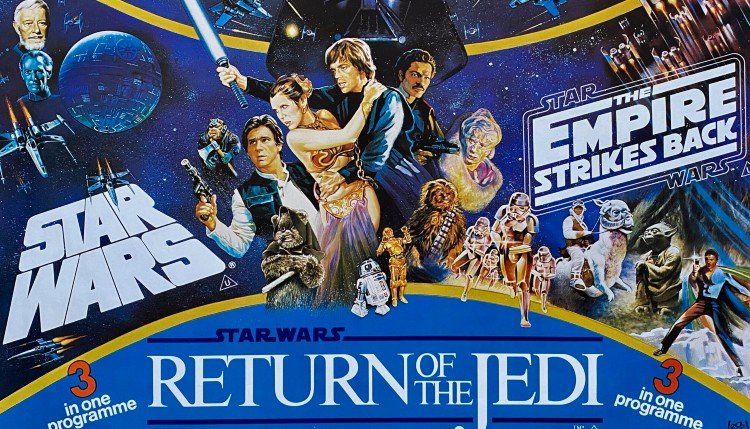Franchise Rewind: Star Wars (1977) The Empire Strikes Back (1980) Return of the Jedi (1983)
Star Wars, 1977 (Mark Hamill) 20th Century Fox/Lucasfilm
The Empire Strikes Back, 1980 (Carrie Fisher) 20th Century Fox/Lucasfilm
Return of the Jedi, 1983 (Harrison Ford) 20th Century Fox/Lucasfilm
“Aren’t you a little short for a stormtrooper?”
One of my favorite things on YouTube is when somebody finds an audio recording of audience reaction (as it happened) during the screening of a movie at the time it was released. One such example is the scene in An American Werewolf in London when Griffin Dunne’s Jack is attacked by the werewolf. You can hear high-pitched screaming all throughout the scene. It’s an earned jump-scare and the screaming is real. This was back in the days when you couldn’t lug a video camera into the theater and pirate your own recording, so you did the next best thing. You took a tape recorder inside and recorded the audio, and then you would get these fantastic audience responses.
There’s a good one floating around with the ending of Star Wars, specifically Luke’s skimming the Death Star trench and blowing up the space station. You got the sense George Lucas preferred to hedge his bets as far as the presumed power and influence of the Force was concerned. It’s true that Luke did indeed fire his proton torpedoes and caused the destruction of the Death Star. It’s also true that had Han Solo not destroyed two of three remaining Tie fighters on Luke’s back, there’d be no sequel.
In the audio tape of the audience reaction to the ending of Star Wars, there are some gasps and some shrieks, particularly when Vader is about to fire on Luke’s X-Wing fighter, but upon the reveal of Han Solo, the theater erupts in cheers and applause. I wish I could go back to that time when people cheered while watching movies. These days, the cheers get duller and duller and end titles are infrequently met with polite applause. Star Wars was monumental.

It was the movie that built off of Jaws’ success in the summer of 1975 two years earlier. Movies began to be released in hundreds, and then thousands, of theaters, and because tickets were much more economically priced, multiple viewings were not uncommon. I had recently watched J.J. Abrams Super 8 when I came to the conclusion that Abrams was simply distilling all that he had seen and experienced watching movies as a kid into the movies he now makes. He can capture the mood and the feeling of a movie made by Lucas or Steven Spielberg, but he doesn’t quite replicate the substance.
Lucas did the same thing with Star Wars, an homage to Flash Gordon and Buck Rogers, Karel Čapek’s R.U.R., Forbidden Planet, Asimov, Clarke and Kurosawa. Farm boy Luke Skywalker is taught the ways of the Jedi by expatriate old warrior Ben Kenobi. Smuggler Han Solo attempts to ferry them to Alderaan but discovers the planet has been destroyed and Solo’s ship is captured by the Galactic Empire’s space station known as the Death Star. They rescue Princess Leia as the Rebellion she leads plans a massive counter-offensive against the Empire.
The reason Star Wars works is because Lucas takes everything seriously, even with the movie’s hip humor—Star Wars is surprisingly snarky for a ’70s movie—and reckless abandon. To hear Lucas tell the story, it almost seemed like a happy accident; that everybody (including Lucas) expected the movie to flop, or at the very least, make back its money and be forgotten. Boy, were they wrong.
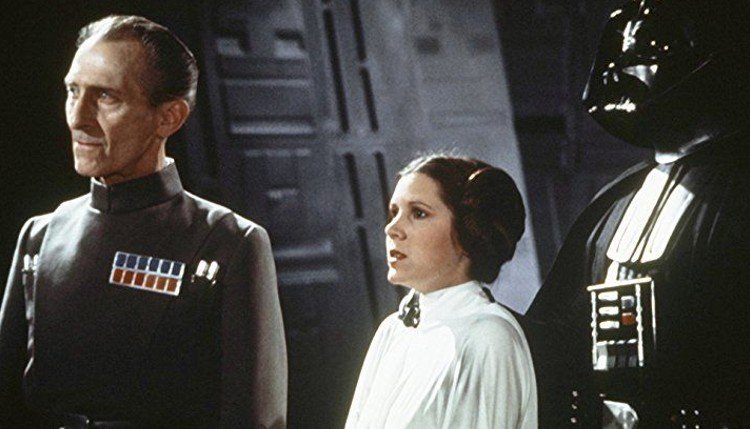
“You said you wanted to be around when I made a mistake, well, this could be it, sweetheart.”
First impressions. Early summer, 1980. Three years after the first Star Wars (which we still referred to as Star Wars and not “A New Hope,” whatever that is), the second movie in the cycle was released. Back to first impressions. Remember that this is a movie now lauded as a classic, as a masterpiece; the greatest Star Wars movie ever made, which it most certainly was, but we weren’t thinking about masterpieces. We were thinking about being pleased as members of the audience.
The Empire Strikes Back was not terribly popular among Star Wars fans at the time of release. I know what you’re thinking. You’re thinking that I’m revising history to justify a narrative I’ve built up for my review, but no—this is the truth—it was not as popular as either Star Wars or Jedi. The numbers bear it out as well. While the sequel was released in more theaters, it made less money than the first Star Wars movie. The reasoning is simple: the movie is a downer, filled with reversal, setbacks, and failures. Our heroes lose. Han Solo is frozen in carbonite and Luke loses a hand.
This is what I wrote in an article for Film Threat a while back: “At its core, Empire has an indie heart and sensibility. Lucas, as well as screenwriters [Leigh] Brackett and [Lawrence] Kasdan are never afraid to deal the characters we’ve come to know and love a crappy hand: the pesky hyperdrive, Luke’s injuries, the failed battle of Hoth, the alarmingly high mortality rate among the Empire’s finest officers at the hands of a pissed-off Sith Lord, the Empire’s takeover of Cloud City, Lando’s betrayal of Han, Han’s torture, Han frozen in carbonite, the failed rescue attempt, and so on. We can identify with characters that are brought to this level. In Star Wars, they are mythic super heroes, defeating their enemies against incredible odds. Here they are human beings up against insurmountable odds because the danger is real. They screw up miserably and their mistakes cause as much trouble for themselves as for the Empire.”

The destruction of the Death Star was a minor setback for the Empire. Vader went off to join the fleet and search for another Rebel base, this time on Hoth. The Empire destroys the base in short order (with the help of marvelous AT-ATs) and Han, Leia, and company evacuate while Luke goes off to find the great Jedi Master, Yoda. Luke’s training is interrupted after he sees visions of a future where Han and Leia are tortured by the Empire, so he decides to leave (against Yoda’s advice—this I’ve never understood) and tries to rescue them.
Even though he had the foresight to know what would happen to Han and Leia, he never suspects that he is being led into a trap. Vader attempts to seduce Luke to join the dark side of the Force, but his mojo doesn’t work so Luke decides to kill himself. He is rescued by Leia and they crawl back to Rebel territory with their respective tails between their legs. The movie ends on a downer note. It doesn’t please the crowd; therefore, it wasn’t going to be as popular in those early years, and even on video a couple of years later you had to get past Empire to watch Jedi.
Going forward decades, at least moving into the ’90s when Randall made the statement in Clerks—“Empire had the better ending. I mean, Luke gets his hand cut off, finds out Vader’s his father, Han gets frozen and taken away by Boba Fett. It ends on such a down note. I mean, that’s what life is, a series of down endings. All Jedi had was a bunch of Muppets.”—this was when Empire began to take on exalted status. Empire did indeed have it all.
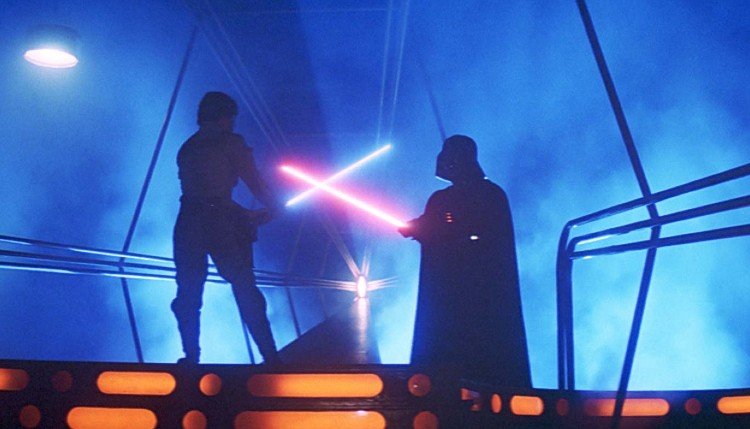
“I’m out of it for a little while, everyone gets delusions of grandeur!”
There are two schools of thought at play when watching Return of the Jedi. If you saw the movie as a child in 1983, you were most likely delighted at the final movie in the Star Wars trilogy. You were bursting with joy at the destruction of the Galactic Empire, the Emperor’s comeuppance, and Skywalker’s transformation into a full-fledged Jedi Knight. Maybe you just blocked out the Ewoks, I don’t know, but it was an incredibly fun experience. When you were a child.
Inevitably, you grow up and put away childish things, but you work in around a hundred viewings of Jedi in between bouts of puberty and adolescent humiliation. This is when Jedi unravels. I don’t think George Lucas ever intended for the movie to be picked apart with the same tools we would ordinarily designate for movies like Citizen Kane or Chinatown. I don’t even think Lucas intended for the first Star Wars movie to be hailed as a cinematic masterpiece.
To hear him talk about it, he wanted the movie to be profitable and perhaps give him opportunities to tell smaller, more personal stories. He never expected his “empire” to be built on the foundation of pulp science fiction fantasy. I can’t help but think about it this way, but I would be lying if I said I didn’t absolutely enjoy Jedi. My mother took me to see it every day in one week. That’s how invested we were in these movies. Star Wars was my life. It still is, in some ways.
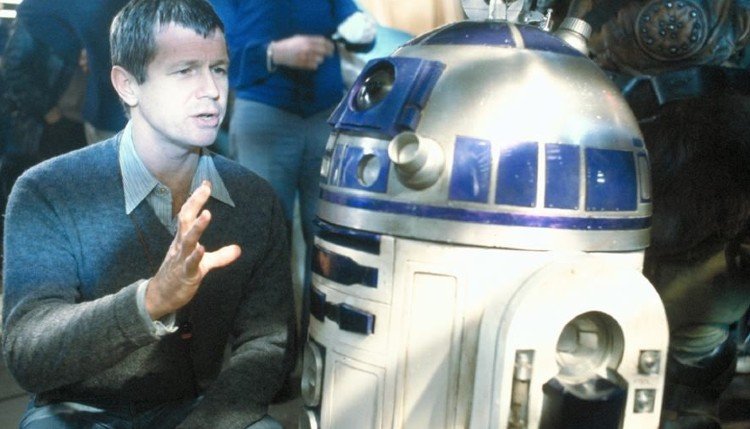
The Empire Strikes Back ends with a quasi-cliffhanger. Frozen in carbonite, Han Solo (Harrison Ford) has been captured by Boba Fett. Luke (Mark Hamill) loses a hand to Darth Vader, who reveals that … (drum roll) Luke’s father is Chewbacca! Just kidding, folks. No. Vader is Luke’s father, so Ben Kenobi kinda lied, or told a fib, or he was being truthful from a certain point of view. Sorry to spoil that for you. Also, Spock dies in Star Trek II and Bruce Willis is a ghost.
I’ve advanced the idea (in other media) that Empire doesn’t actually end, or “close the circle” of the story until Han is rescued from the clutches of vile gangsta Jabba the Hutt, and then we can move forward with Jedi, which turns out to be a remake (of sorts) of the first Star Wars movie. We have a second Death Star and a plan (courtesy of the doomed Bothans) to blow ‘er up but good! This one’s just a hair more difficult than skimming a trench and sinking a proton torpedo to get to the space station’s creamy nougat center.
This time, Han (now promoted to General, huh?), Leia (Carrie Fisher), and Luke are required to land on the forest moon of Endor and shut down the shield that protects the new Death Star. Once the shield is disabled, Lando (Billy Dee Williams), in the Millennium Falcon, must destroy the station’s power reactor from the inside. Unfortunately, Luke knows Vader can sense him so he disconnects himself from the group shortly after the Rebels forge an alliance with the ridiculously cute Ewoks.
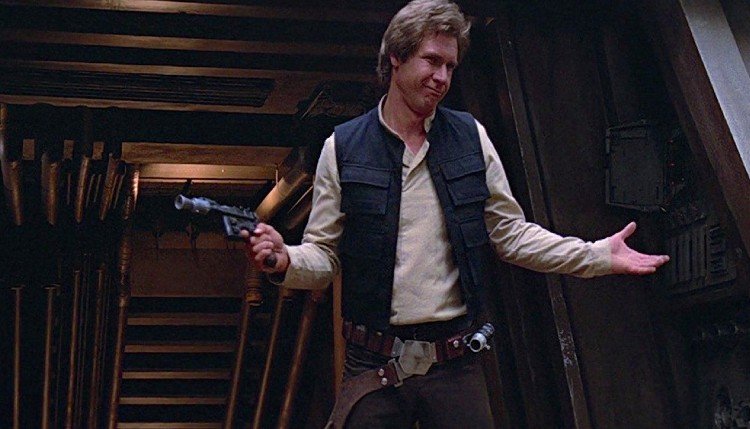
Luke surrenders to Vader, who takes him to the Emperor (Ian McDiarmid, who would reprise his role in the prequels and The Rise of Skywalker). The Emperor’s dialogue indicates he’s a stickler for prophecy. His motivation is turning Luke to the “dark side” of the Force by killing either Vader or himself. What’s more important to the Emperor? That Luke kill him, or that Luke become the new Jedi “face” of the Empire? I’m not sure, but I do know it doesn’t make sense, no matter how many times Lucas and co-writer Lawrence Kasdan keep reminding us with the repetitive dialogue.
It goes on like this for a while in the final act. We get decent, if improbable, action set pieces on the forest moon with the always incompetent stormtroopers, biker scouts, and assorted Ewoks. There are victories and reversals and then more victories on the forest moon and Death Star that are edited to coincide with each other. It has always seemed convenient to me that Solo and his party manage to bring down the shield just as Luke manages to defeat Vader, as well as Vader’s last-minute recant and murder of the Emperor, but we’re with our heroes all the way, no matter how ridiculous the circumstances.
We want them to win. Where Jedi is uninspired in its storytelling, it compensates with incredible visual effects and a fast pace. If at all possible, avoid “special” editions of the movie. Try to dig up an old VHS tape or laserdisc! You’ll be glad you did!

